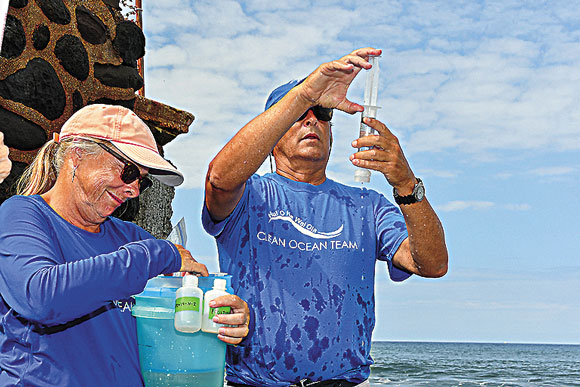Report on West Maui ocean water quality to be presented at Lahainaluna High SchoolLahaina News
LAHAINA – How clean is the ocean water along the shores and at the beaches of West Maui? The public is invited to learn the answer to this question at a free presentation showcasing the results gathered by Hui O Ka Wai Ola, a unique community-based coastal water quality monitoring program co-managed by Maui Nui Marine Resource Council, The Nature Conservancy and West Maui Ridge to Reef Initiative. The presentation will take place on Tuesday, July 30, from 6 to 7:30 p.m. at the Lahainaluna High School Cafeteria in Lahaina. Admission is free. Residents and visitors are welcome. The evening will feature results from two years of ocean water quality monitoring at 19 West Maui locations from Honolua Bay to Papalaua near the Pali. "Come learn about the scientific data that our volunteers and staff have gathered through their diligent work in the field and in the lab," said James Strickland III, project manager of Hui O Ka Wai Ola. "We encourage everyone to attend to learn about the water quality issues that we've found in West Maui." Hui O Ka Wai Ola (Association of Living Waters) is the first citizen science-based water quality monitoring program of its kind in Hawaii that works in close cooperation with the state Department of Health's Clean Water Branch to provide scientific, quality-assured data for use by the state and county government, community groups, researchers and the public. More than 40 Maui residents volunteer with Hui O Ka Wai Ola. Since monitoring began in 2016, the program has collected and analyzed over 700 water quality samples from 49 sites in West and South Maui. "Our primary motivation for launching this program was the health of Maui?s coral reefs," said Robin Newbold, co-founder and chair of the Maui Nui Marine Resource Council. "Coral reefs need clean ocean water to survive, especially during this time of warming ocean water, sea level rise and climate change. Having this data is an important step in working for clean ocean water along our coasts." The program follows a strict Department of Health (DOH) approved Quality Assurance Project Plan. As a result, the DOH readily accepts the hui's data and incorporates it into its reports and databases. Every three weeks, trained volunteers wade into knee deep water to gather ocean water samples from the 39 monitored locations in leeward Maui, conducting evaluations of salinity, water temperature, dissolved oxygen, pH and turbidity (sediment) at portable labs carried in the volunteers'? cars. Additional analysis of the samples takes place in labs that are hosted pro bono by the Hawaiian Islands Humpback Whale National Marine Sanctuary and Lahainaluna High School. The samples are also frozen and shipped to the SOEST Analytical Laboratory on Oahu for additional analysis of nitrogen and phosphorous compounds. By identifying where water is impaired and why, the community can begin to identify the sources of the impairment. "For example, when we find areas with high levels of nutrients, we can look for upslope issues like chemically intensive landscape management practices or historic agricultural that impacts the ocean through runoff or via the groundwater," said Tova Callender, coordinator of the West Maui Ridge to Reef Initiative. All data collected by the hui is made available to the public at HuiOKaWaiOla.com, PacIOOS, and Zenodo. The data has also been uploaded to the Environmental Protection Agency's STORET database for use by state and federal agencies. This data has been included in the State of Hawaii Clean Water Branch's Integrated Report to the EPA, "2018 State of Hawaii Water Quality Monitoring and Assessment Report". "This community-based program is an excellent example of how people can organize to supplement the efforts of our hardworking state agencies," said Kim Falinski, marine science advisor for The Nature Conservancy. "Our program has paralleled state-collected data protocols and developed standards available for groups in Hawaii and beyond to adopt in creating similar programs." The Hui O Ka Wai Ola program is a partnership between the Maui Nui Marine Resources Council, The Nature Conservancy and the West Maui Ridge to Reef Initiative. It is supported by the Maui County Office of Economic Development, Hawaii Tourism Aloha 'Aina Program, North Beach West Maui Benefit Fund, Napili Bay and Beach Foundation, National Fish and Wildlife Foundation, Lush Cosmetics, The Makana Aloha Foundation, Honua Kai West Maui Community Fund, as well as individuals, families and local businesses. To learn more, visit www.huiokawaiola.com or www.mauireefs.org. Original article URL: https://www.lahainanews.com/news/local-news/2019/07/25/report-on-west-maui-ocean-water-quality-to-be-presented-at-lahainaluna-high-school/ |

